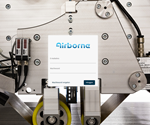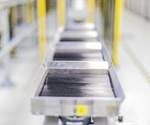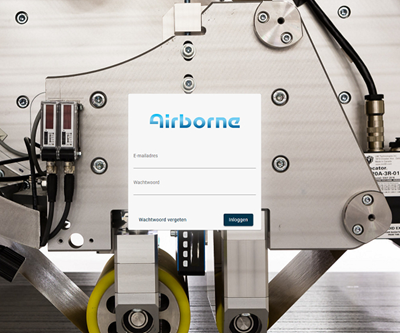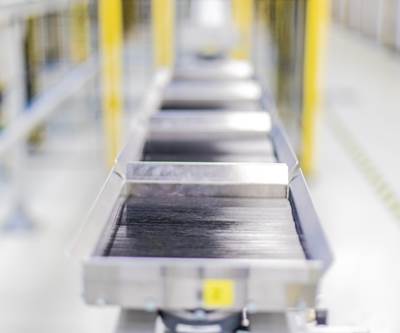Severstal invests in Airborne automated composites manufacturing
Airborne will work with steel company Severstal to explore integration of metal and composites.
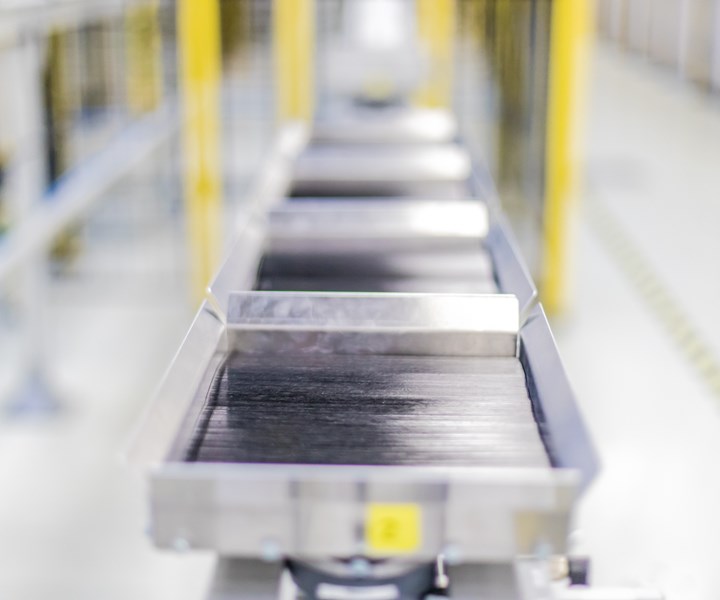
CW covered Airborne and SABIC’s high-speed system for producing consolidated laminates from thermoplastic composite tapes, called the Digital Composites Manufacturing Line, in August 2019. Image source | SABIC
Integrated steel and mining company (Moscow, Russia) announced on Jan. 21 that it has invested in digital automation platforms specialist Airborne (The Hague, Netherlands), and that as part of this collaboration, Airborne will work with Severstal’s technical development and quality department to examine the potential of integrated solutions based on composites and steel. Severstal will offer its clients the opportunity to test these integrated solutions.
Airborne has developed and brought to market a set of digital technologies that increase the efficiency of carbon fiber composite production by automating the production process. The company is in the process of commercializing the automated production cells and software. At its facilities in the Netherlands and the U.K., Airborne manufactures composite products for a range of sectors including the automotive, construction, shipbuilding, aerospace, electronics and wind power industries.
According to Severstal, using automation cell technology can help reduce the cost of producing composite products and their development cycle while ensuring consistent quality at a high production speed.
“We are convinced that, going forward, the greatest demand from key industries will be for a ‘multi-material offer’ of composites containing a combination of materials, including steel.”
Severstal joins other investors in this investment round, including advanced materials venture capital fund Pangaea Ventures (Vancouver, Canada) and chemical company SABIC (Riyadh, Saudi Arabia).
“With our investment in Airborne, we are continuing to move towards our goal of achieving integration between metals and composites in the innovative solutions we offer our clients,” says George Gogolev, head of Severstal Ventures. “We believe this technology could transform the composites market in the next five to seven years by significantly reducing the price of end products. This will impact the metal market by enabling us to offer our customers new materials with unique properties that are not currently achievable in steelmaking. … [W]e are convinced that, going forward, the greatest demand from key industries will be for a ‘multi-material offer’ of composites containing a combination of materials, including steel.”
“… Together with Airborne, we plan to explore opportunities to move towards integrating metals and composites in our innovative customer solutions,” says Andrey Laptev, director of business development and corporate venture projects at Severstal. “With Airborne’s unique automation platform, customers will be able to place their orders directly on the appropriate portal, and receive an affordable product that meets their needs. On a global scale, we see huge potential for composite materials, the market value of which is estimated at $90 billion. Severstal is delighted to provide the team at Airborne with our support, and to be its first partner from the steel industry.”
“... We see that the global trend of lightweighting as a way to drive sustainability employs a great deal of multi-material solutions that combine the strength of metals and composites. While the steel industry is already very industrialized and efficient, the composite industry expresses a strong need to drastically reduce cost and improve efficiency, in order to accelerate the adoption of composites and enable its full potential. This can be done by automating the manufacturing process, as well as by digitalizing the full value chain to make design and manufacturing highly efficient, easy and flexible. We very much look forward to the collaboration,” says Arno van Mourik, CEO of Airborne.
Related Content
Welding is not bonding
Discussion of the issues in our understanding of thermoplastic composite welded structures and certification of the latest materials and welding technologies for future airframes.
Read MoreCutting 100 pounds, certification time for the X-59 nose cone
Swift Engineering used HyperX software to remove 100 pounds from 38-foot graphite/epoxy cored nose cone for X-59 supersonic aircraft.
Read MorePlant tour: Airbus, Illescas, Spain
Airbus’ Illescas facility, featuring highly automated composites processes for the A350 lower wing cover and one-piece Section 19 fuselage barrels, works toward production ramp-ups and next-generation aircraft.
Read MoreComposites end markets: New space (2025)
Composite materials — with their unmatched strength-to-weight ratio, durability in extreme environments and design versatility — are at the heart of innovations in satellites, propulsion systems and lunar exploration vehicles, propelling the space economy toward a $1.8 trillion future.
Read MoreRead Next
Airborne launches composite printing portal
The first application of the portal is for thermoset laminates manufactured in prepreg material by Airborne’s Automated Laminating Cell (ALC) technology.
Read MoreHigh-speed, high-rate thermoplastic composites manufacturing
A novel process from SABIC and Airborne promises high-speed, high-rate production of thermoplastic composite laminates for mainstream manufacturing and a variety of applications.
Read MoreScaling up, optimizing the flax fiber composite camper
Greenlander’s Sherpa RV cab, which is largely constructed from flax fiber/bio-epoxy sandwich panels, nears commercial production readiness and next-generation scale-up.
Read More.jpg;width=70;height=70;mode=crop)
